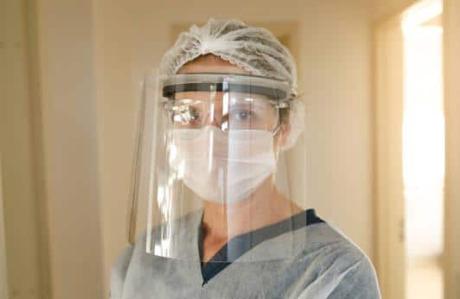Which face covering is better? Face masks or Face shields? This article compares face shields against face masks. It also discusses the advantages face shields have over face masks.
The CDC still maintains that in situations where social distancing measures are difficult to observe, you should wear a face mask. Face masks act as barriers that prevent respiratory droplets from travelling into the air when you sneeze, cough or raise your voice. In medical terms, this is referred to as source control. Masks with exhalation valves or vents are not effective in coronavirus source control. This is because they allow air to be exhaled and this can result in the exhaled airborne droplets reaching others.
According to the US Food and Drug Administration, the best facial covering is one that tightly covers your face and effectively filters small airborne particles.
What is a Face Shield?
As the CDC continues to urge people to wear face coverings, some people have opted to wearing face shields instead of face masks. Others have chosen to wear face shields together with face masks. Those wearing face shields instead of face masks argue that plastic face shields are more comfortable to wear than face masks. The prolonged wearing of face masks can cause maskne. Maskne is a skin irritation caused by prolonged face mask wearing.

A face shield is a curved plastic attached to a headband usually worn to cover the face. In healthcare settings face shields are used by doctors and nurses during surgeries where blood, body fluids and bone fragments may fly out and get into their mouth, nose or eyes. They are also worn by doctors when intubating COVID-19 patients.
What advantages do face shields have over face masks?
Face shields are becoming a popular sight on the streets. More and more people have opted to wearing face shields because of the advantages they have over face masks. In this article in the Journal of the American Medical Association, Eli Perencevich, a professor of epidemiology at the University of Iowa ,writes that face shields protect your eyes. Eyes can be an entry point into your body of contaminated airborne particles. When you wear a face shield, the risk of touching your face and introducing any contaminated particle your hands may have picked is greatly reduced.
Unlike surgical masks which have a limited durability, face shields can be cleaned and reused almost indefinitely. Face shields can be easily cleaned with soap and water making them eco-friendly. Cleaning of medical masks such as N95 respirators requires complex methods such as heating and the use of UV light.
Another advantage that face shields possess is that they are considered to be more comfortable and convenient than face masks. Unlike face masks, you do not have to remove them to be able to communicate effectively. Face shields do not need constant adjustment once worn as is the case with face masks. Lastly, face shields have the ability to keep your entire face visible and they allow you to show facial expressions.
Are Plastic Face Shields effective in reducing the spread of COVID-19?
Opinion on whether wearing a face shield reduces the risk of contracting the novel coronavirus is divided. An argument has been advanced by infectious disease experts that a plastic face shield is more effective when worn together with a face mask.
In this opinion piece by Eli Perencevich and his two colleagues from the University of Iowa, a face shield is only effective in reducing the spread of COVID-19 if it extends to below the chin. The face shield should also cover your ears and "there should be no exposed gap between the forehead and the shield's headpiece.
There are medical experts who believe that face shields are not effective in reducing the spread of COVID-19. They argue that even though face shields block small particles, these particles may move around the sides of the visor and eventually spread over a large area. These aerolisized droplets, if contaminated, are responsible for spreading the coronavirus from one infected person to the other.
The US Center for Disease Control does not recommend the wearing of face shields as a substitute to face masks. The agency says that there is no evidence that shows the effectiveness of face shields.
In an interview with CBSN, Dr. Shoshana Ungerleider, an internal medicine physician said that face shields are not sufficient protection against COVID-19. She argues that the novel coronavirus spreads through microscopic airborne particles that can easily get around the open sides. The sides and bottom of a face shield are open. She emphasizes the need for people to continue wearing face masks, uncomfortable and irritating as it may be.
Getting the most benefit from a plastic face shield
There are a few things you have to keep in mind should you decide to wear a face shield. These simple guidelines by Dr Joy A. Henningsen will help you get the most benefit from a face shield:
- The face shield should fit squarely. There should be no gap between the shield's headpiece and your forehead
- The face shield should extend well below the chin.

In conclusion, face shields have been found to possess several advantages over face masks. They are more comfortable to wear. Face shields, however, are not as effective in reducing the spread of COVID-19 as face masks. Because they are not approved by the CDC, face shields should not be used in place of face masks. In fact, any facial covering that is not approved by the CDC should not be used as a method of source control. To reduce the risk of spread of COVID-19, a face shield should only be worn together with a face mask.
- When you remove the face shield, do not touch the front of the plastic shield.
- Sanitize your face shield once you take it off. Face shields can be cleaned with soap and water, an alcohol pad or with an antibacterial wipe. Thoroughly wash your hands with soap and water after handling the face shield.
- Disposable face shields should be thrown away in a closed bin after each use.
- A face shield should always be worn together with a face mask. When worn alongside a face mask, face shields give the most benefit.

